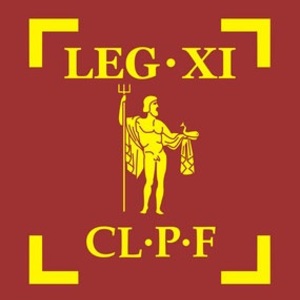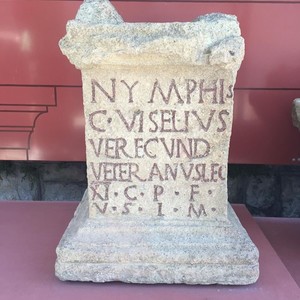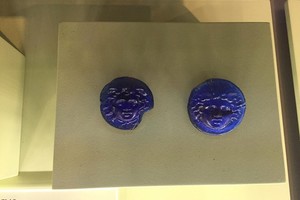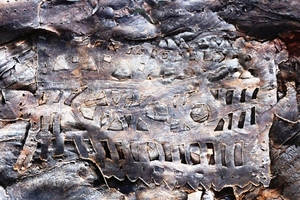Roman Legion - Legio XI Claudia
Legio XI Claudia — a Roman legion (Eleventh Legion Claudia) formed by Julius Caesar.
Dates of existence: 58 BC, lasted until the 5th century AD.
Symbol: Bull, Neptune, possibly the Capitoline Wolf.
Titles: Claudia, Pia Fidelis (Faithful and Loyal), Pia VI Fidelis VI (Six Times Faithful and Loyal).
Battle Path
- In 58 BC, Legio XI was created along with Legio XII Fulminata by Gaius Julius Caesar to participate in the Gallic Wars (58-50 BC). Both new legions were formed in northern Italy in the area of Cisalpine Gaul (a territory inhabited by Celts and conquered by the Romans in the 3rd century BC).
- After that, both legions were transferred to distant Gaul to take part in Caesar’s Gallic War. Legio XI’s baptism of fire was the battle on the Sabis River (today a tributary of the Meuse, near the modern Franco-Belgian border) in 57 BC. Caesar mentions the legion’s involvement in this battle: "likewise, in another part, the two legions, the 11th and the 8th, drove the Veromandui from the high ground where they had engaged in close combat, and were now fighting on the very banks of the river" (Caesar, "Commentaries on the Gallic War", Book II). After this battle, it is unknown in which battles of the Gallic War the legion participated until 54 BC, but it is a fact that it fought in Gaul.
- In 54 BC, Caesar’s "Commentaries on the Gallic War" reveal what happened to the legion during the wintering in the lands of the Belgae. Legio XI was quartered when it was attacked by the uprising and united tribes of the Nervii, Eburones, and Aduatuci. Caesar himself with his troops helped lift the siege and defeated the combined enemy forces. This episode in the legion's history is interesting for two reasons. Firstly, at that time, the legion was commanded by Quintus Tullius Cicero (the younger brother of the famous Roman politician and orator Marcus Tullius Cicero). Secondly, during this siege, two centurions distinguished themselves, who competed with each other, aspiring for the promotion to the rank of senior centurion, disputing who was more worthy of this position. These centurions were named Titus Pullo and Lucius Vorenus. More about their bravery can be found in Caesar's "Commentaries on the Gallic War", Book II. Caesar will mention Pullo again among Pompey's legionaries in the battle of Dyrrhachium in 48 BC.
- It is known for sure that the legion participated together with other legions involved in Gaul in the siege and battle under the walls of Alesia (modern Ales-Saint-Reine in France) in the autumn of 52 BC when part of the Gauls, who came from outside the Roman siege ring around Alesia, tried to break through and join their comrades from Alesia, who went to break through the Roman fortifications from within the ring. The battle ended in complete defeat for the two Gallic armies, and their leader Vercingetorix surrendered to Caesar. But the war continued until Caesar’s forces completely subdued the territory of Gaul in 50 BC.
- The legion distinguished itself in the winter campaign of 51-50 BC, serving as the rear guard of Roman forces in northern Gaul, which pacified lands inhabited by the Bituriges, Carnutes, Bellovaci, and Eburones tribes.
- In the Civil War, the legion sided with Caesar and fought in two major battles of that war, both occurring in 48 BC. The first was the battle of Dyrrhachium in spring 48 BC (modern Durrës, Albania). The second was the battle of Pharsalus in summer 48 BC (modern Pharsala, northeastern Greece). These battles are described by Caesar in his third book "The Civil War". Having suffered heavy losses at the battle of Pharsalus, the legion was withdrawn for replenishment to Italy and did not take part in the further events of the civil war between Caesar and Pompey.
- In spring 45 BC, after Caesar's victorious conclusion of the Civil War, some legions were disbanded, among them Legio XI. Its veteran legionaries were settled in colonies in Italy. Most traces of Legio XI veteran settlements in Italy are found in the cities of Atesia (modern Este, Italy) located in northeastern Italy, and Bovian (modern Boiano, Italy) in the southern part of central Italy.
- The legion was reformed after Caesar's assassination in 44 BC by Octavian Augustus in 42 BC.
- Legio XI participated in the key battle between Caesar's supporters and his assassins - the battle of Philippi (October 42 BC) on Octavian Augustus's side.
- After the defeat of Caesar's assassins in 41 BC, due to the distribution of land to the legion's veterans in Italy, a rebellion known as the "Perusine War" (autumn 41 - spring 40 BC) broke out. One of the leaders of this rebellion was Lucius Antonius, the brother of Mark Antony. Legio XI was involved in suppressing this rebellion. These events and the involvement of the Eleventh Legion are mentioned by the ancient Roman historian Appian in his work "Civil Wars", Book IV.
- After this, the legion took part in the civil war between Octavian and Mark Antony on Octavian's side and participated in the key battle of this war – the battle of Actium in September 31 BC. Interestingly, Antony also had his legion with the eleventh number (Legio XI), but it is unknown how he obtained it.
- After the end of the civil war between Antony and Octavian (in 27 BC), which Octavian won, the legion remained in Italy for some time and was then transferred to the Roman province of Illyricum, where it remained until the early years of our era.
- It is possible the legion participated in the military campaigns of Drusus the Elder and Tiberius to the Danube River, but there is no precise data on its participation in these events.
- In 9 AD, the legion participated in suppressing the "Great Illyrian Revolt" and was subsequently stationed by Emperor Augustus in the province of Illyricum. Here, the legion was stationed in a large military camp near the city of Burnum (modern Kistanje, Croatia).
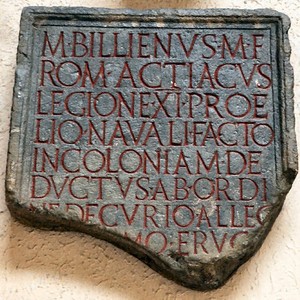 Surviving Fragment of a Tombstone Mentioning a Veteran of the Eleventh Legion from Vicenza (Italy): “Marcus Billien, son of Marcus, from the Romilieus tribe, from the Eleventh Legion of Actium. Participated in the naval battle, settled in the colony, appointed decurion by decree, a valiant man.” Rome, Museum of Roman Civilization, end of the 1st century BC - beginning of the 1st century AD.
Surviving Fragment of a Tombstone Mentioning a Veteran of the Eleventh Legion from Vicenza (Italy): “Marcus Billien, son of Marcus, from the Romilieus tribe, from the Eleventh Legion of Actium. Participated in the naval battle, settled in the colony, appointed decurion by decree, a valiant man.” Rome, Museum of Roman Civilization, end of the 1st century BC - beginning of the 1st century AD.
- Besides the main camp in Burnum, detachments of Legio XI were stationed in the city of Salona, the capital of the province, and together with detachments from Legio VII, which was also stationed with Legio XI in this province, guarded the fortress of Tilurium (modern village of Gardun, Croatia) on the approaches to Salona.
- Under the emperors Tiberius (ruled 14-37 AD) and Caligula (ruled 37-41 AD), Legio XI continued to be stationed in the province of Dalmatia, where it had been placed by Emperor Augustus in 9 AD.
- During this period, the legionaries of Legio XI were engaged in construction work. They rebuilt and strengthened their camp in the city of Burnum, buildings in the capital of the province (city of Salona), and laid roads between their outposts in the province.
- During the reign of Emperor Claudius (ruled 41-54 AD), the governor of the province of Dalmatia, Lucius Arruntius Camillus Scribonianus, rebelled against the emperor in 42 AD, but the legions stationed in the province (Legio XI and Legio VII) did not support the rebel, who soon perished.
- In gratitude for the loyalty shown to him by the legions, Emperor Claudius granted them the cognomina "Claudian, Faithful [Pious] and Loyal." This is mentioned by the Roman historian Dio Cassius in his work "Roman History", Book LX, (3). From then on, Legio XI would be called Legio XI Claudia Pia Fidelis (Eleventh Claudian Faithful and Loyal Legion) until its disbandment. Emperor Claudius also allocated funds for repair work in the legion's camp in Burnum and the construction of an amphitheater nearby. During Claudius's reign, a city-colony of veterans from Legio XI Claudia and Legio VII Claudia was established in the province of Dalmatia in 9 AD, named Equum (modern Bosnian city Čitluk, in southern Bosnia and Herzegovina, near Mostar).
- It is possible that a detachment of Legio XI Claudia participated in Corbulo's eastern campaign in 62-63 AD in Syria during Emperor Nero's reign, but there is debate about this in scientific circles. It is known that due to political events in the East, some legions changed their stationing, including Legio VII Claudia, which had long been stationed with Legio XI Claudia in the province of Dalmatia. Thus, Legio XI Claudia remained the sole military unit in the province of Dalmatia.
- During the civil war that broke out after the death of Emperor Nero (Year of the Four Emperors), Legio XI Claudia initially supported Otho. After his defeat, the legion supported Vespasian and participated in the Battle of Cremona (Bedriacum, the modern city of Cremona in northern Italy) in 69 AD.
- In 70 AD, the legion took part in suppressing the Batavian revolt, after which the legion was transferred to its new camp at Vindonissa (the modern city of Windisch in Switzerland).
- During the reign of the last emperor of the Flavian dynasty, Domitian (ruled 81-96 AD), the legion participated in the war against the Chatti.
- In 101 AD, the legion was transferred to the city of Brigetio in Pannonia (a Roman province located in Central Europe, covering parts of modern Hungary, Austria, Slovakia, Slovenia, Croatia, Serbia, and northern Bosnia and Herzegovina).
- In 114 AD, the legion was transferred from Brigetio to Durostorum (the modern city of Silistra in Bulgaria). In this region, the legion was tasked with ensuring security and order at the mouth of the Danube. During this time, one of Legio XI Claudia’s detachments was periodically sent to guard and maintain order in Crimea (Taurica), which was under Roman control at the time.
- During the reign of Emperor Hadrian in 132-136 AD, Legio XI Claudia participated in suppressing the Bar Kokhba revolt in Judea.
- At the end of the 2nd century, in the Year of the Five Emperors (193 AD), Legio XI Claudia sided with Septimius Severus. It participated in battles against another contender for power, Pescennius Niger. The legion besieged Byzantium (modern Istanbul, Turkey) and participated in the Battle of Issus (modern Issus, Turkey) in 194 AD.
- During the reign of Emperor Gallienus (August 253 – August 268 AD), Legio XI Claudia supported him instead of his opponent Postumus, earning the title Pia VI Fidelis VI ("Six Times Faithful and Loyal").
- In the late 3rd century (295-298 AD), parts of Legio XI Claudia fought in Roman Egypt and Mauretania (northwestern Africa, covering parts of modern Algeria (its western part) and Morocco (its northern part)).
- At the beginning of the 4th century (302 AD), Legio XI Claudia was stationed in Durostorum. By this time, Christianity had become popular within the legion, and as punishment, the command subjected two Christian legionaries, Julius and Hesychius, to fatal tortures.
- In the early 5th century, the legion was still stationed in Durostorum. Its subsequent fate is unknown.
Related topics
List of Roman Legions, Legion, Legionnaire, Legio X Fretensis, Legio VII Claudia, Legio XII Fulminata, Gaius Julius Caesar, Octavian Augustus, Year of the Four Emperors, Year of the Four Emperors
Literature
- R. Kanya "Legion" A brief description of the history of various legions on the XLegio portal.
- Dandelot-Collins "The Complete History of the Roman Legions".
